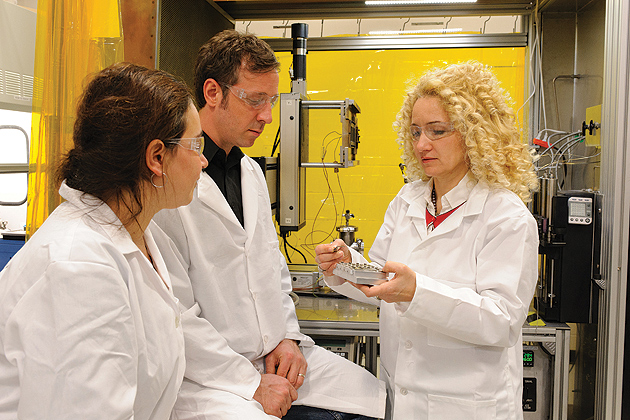UConn’s Center for Clean Energy Engineering has developed a new manufacturing process for fuel cells that could make highly efficient, fuel cell-powered vehicles a viable commercial option in the next 10 years and possibly sooner.
Professor Radenka Maric developed the breakthrough process, which significantly lowers production costs while maintaining maximum efficiency. The process is not limited to hydrogen fuel cells. It can be applied in other industrial applications to extend the durability and efficiency of larger solid oxide fuel cells, used to heat and provide electricity to buildings, as well as lithium-ion batteries currently used in most battery-powered, plug-in, and hybrid cars.
Hydrogen fuel cells, also known as Proton Exchange Membrane (PEM) fuel cells, are an attractive alternative fuel source for vehicles because of their high level of efficiency, low greenhouse gas emissions, and environmentally friendly operation. They have no moving parts, and their only emission is water and heat.
But one of the primary drawbacks to the widespread use of the cells is that they are expensive to manufacture because platinum, a rare and expensive metal used as catalyst material to create energy, is one of the cell’s main components.
At UConn’s clean energy engineering facility, Maric has developed a prototype manufacturing process for the fuel cells that uses 10 times less catalyst material with little waste. The low-temperature process allows for important industrial controls and flexibility, and can be easily scaled up for mass production.
“We are trying to reduce the processing steps, and that is going to reduce the cost of manufacturing,” says Maric, the Connecticut Clean Energy Fund Professor in Sustainable Energy in the School of Engineering’s Department of Chemical, Materials, and Biomolecular Engineering. “Many times, an industry starts working on something with the technologies they inherit. They may make the first generation of products, but they are always looking for that next generation that is better and cheaper. That is what we are focusing on – the next generation.”
Maric is internationally recognized for her work with fuel cells, thin films, and nanomaterials technology. Prior to coming to Storrs in 2010, Maric was a group leader and program manager at the National Research Council of Canada’s Institute for Fuel Cell Innovation. Earlier in her career, she was a senior scientist and team leader working on material development for fuel cells and batteries at the Japan Fine Ceramics Center in Nagoya, Japan. Maric has published more than 150 scientific papers and holds several patents.

In response to industry demand for lower manufacturing costs, increased durability, and increased efficiency for fuel cells, Maric created a novel production process known as reactive spray deposition technology, or RSDT. In the process, small particles of catalyst material, such as platinum, are shot out of a nozzle in the form of a gas flame, where they are instantly cooled into atom-sized solids and sprayed onto the fuel cell membrane in a carefully calibrated fine layer.
The flame-based dispersion of the catalyst material allows it to bond to the membrane quickly, eliminating several binding and drying steps necessary in the current manufacturing process. By applying such a fine layer of catalyst material and by achieving greater control of the size and saturation rate of the particles, the RSDT process also limits waste.
The flexibility and control standards of the process further allow manufacturers to manage the thickness of the material layers that are applied, which is important in fuel cell technology. Material layers in fuel cells need to be thin enough to provide maximum conductivity when used in low-temperature hydrogen fuel cells, yet thick enough to prevent corrosion and maintain durability at the high temperatures at which solid oxide fuel cells operate.
The RSDT process can also be applied in the production of more advanced lithium-ion batteries. Similar to what it does with hydrogen fuel cells, RSDT’s direct dry application of the nanocoatings used inside the battery eliminates several binding steps in the current manufacturing process. Its high level of particle control and flexibility allows developers to use less material at less cost.
Industry interest
Several Connecticut companies, including Sonalysts Inc. of Waterford and Proton OnSite of Wallingford, are currently considering Maric’s production techniques for industrial and commercial applications.
Researchers at Sonalysts are helping the U.S. Office of Naval Research find ways to improve the safety and reliability of lithium-ion batteries through the use of nanotechnology and advanced thermal management. The company is also investigating new ways to improve the efficiency of Proton Exchange Membrane fuel cells by reducing the amount of the required catalyst.
“Professor Maric’s rapid spray deposition technology offers the potential of performance and reduction of manufacturing costs for both of these products,” says Armand E. Halter, vice president of applied sciences at Sonalysts. “Our initial tasking is directed to investigate the benefits of RSDT to enable catalyst deposition directly upon high-temperature membranes … at substantially lower weight loadings. … With good results, we anticipate expansion of this development work as the program moves forward.”
At Proton OnSite, a global hydrogen energy and technology company, Katherine Ayers, the company’s director of research, says she, too, is interested in Maric’s use of the reactive spray deposition technique.
“Our interest is in the potential for this technology to enable much lower amounts of expensive catalyst metals, while still providing mild processing conditions at the membrane surface to avoid damage to the membrane,” says Ayers. “We also believe this technology has the ability to substantially reduce labor and scrap, especially due to the short shelf-life of most inks currently used for electrode processing.”


